#Rumex sanguineus
Text

Rumex sanguineus / Red-Veined Sorrel
#Rumex sanguineus#Red-veined sorrel#Red veined sorrel#Bloody dock#Red veined dock#Red-veined dock#Nature photography#Edible plants#Home
3 notes
·
View notes
Text
Blood Vein Sorrel
I planted the first thing in the food forest that makes it like a food forest - blood sorrel! It’s sorrel, but creepier! It’s still little but should grow well if the other sorrel elsewhere in the garden (lawn) is anything to go by.

I have a few fruit trees and fruit bushes and sunflower seeds in there, but this is the first plant that makes it look like more than devastation and mud with some pathetic sticks planted in it.
Here it is amongst the mud with some “mulch” to make it feel at home with the rest of the plants.

2 notes
·
View notes
Text
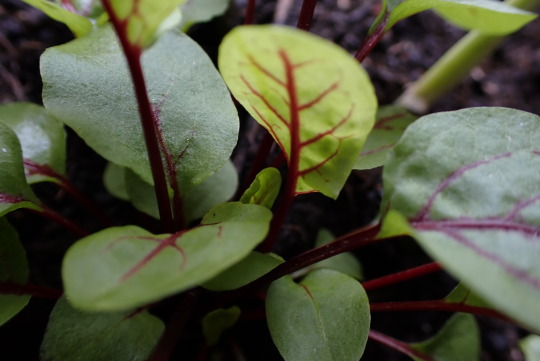
5.10.2023: Rumex sanguineus
#phototagebuch#tagesphoto#photo diary#photo of the day#photojournal#photo du jour#photo des tages#vienna#wien#urban garden#blut-ampfer#Rumex sanguineus#5.102023
0 notes
Text

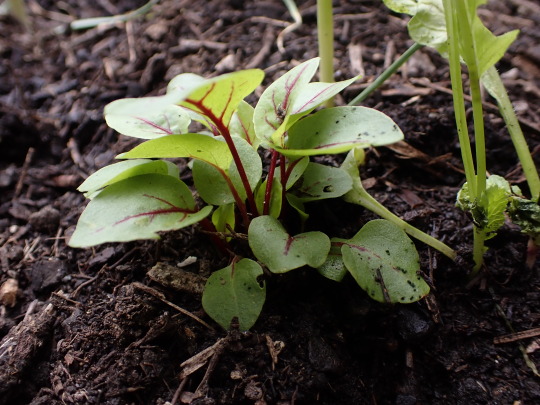
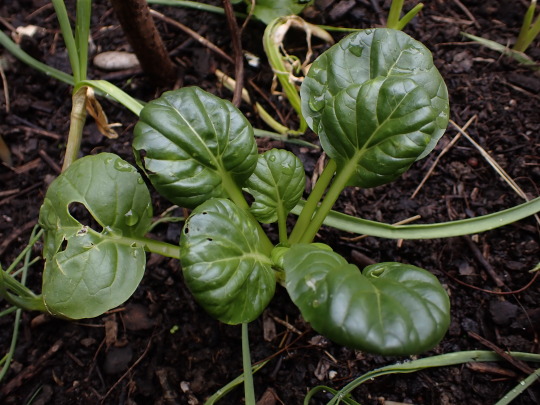
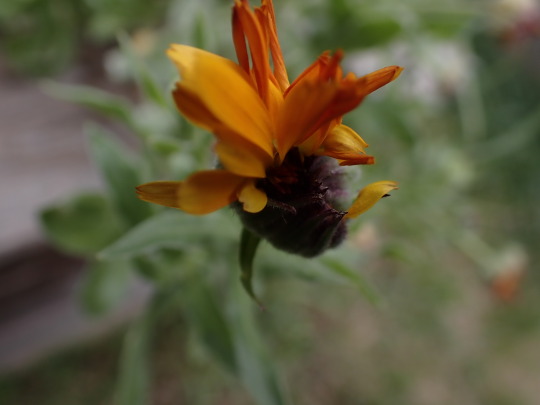



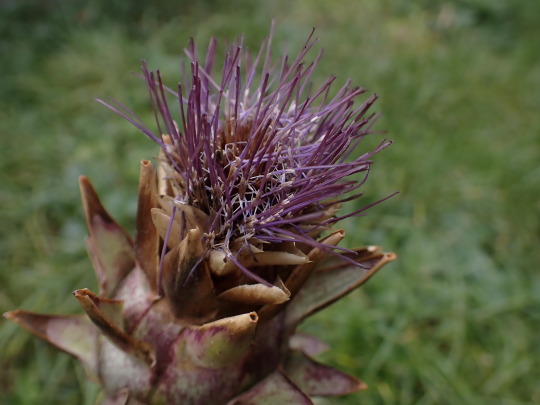


#pflücksalat#blutampfer#urban garden#schmelzgarten#wien#Rumex sanguineus#tatsoi#rosetten pak choi#pak choi#24.9.2023#ringelblume#Calendula officinalis#zitronenmelisse#Melissa officinalis#artischocke#Topinambur#Helianthus tuberosus#Mangold
0 notes
Photo
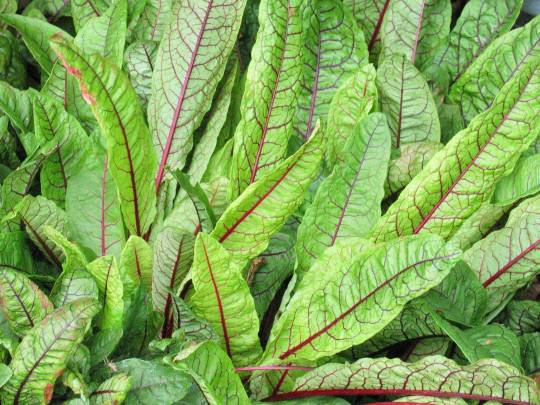
Rare Bloody Dock Red Sorrel Seeds Heirloom Non-GMO BN50 Bloody Dock Red Sorrel (Rumex sanguineus). Stunning foliage plant with elongated, medium green leaves, exquisitely veined in a brilliant burgundy-purple. A hardy perennial, it quickly forms an attractive clump, which sends up red flower clusters in early summer, followed by brown seed heads. A superb, deer-resistant accent plant. Count: 50+ 6-12 hours of Sun Sprouts in 10-14 Days Ideal Temperature: 65-75 Degrees F Seed Depth: 1/4" Plant Spacing: 10-12" Frost Hardy: Yes Type: Annuals, Perennials Sun Exposure: Full Sun Water: Regular Water Family: Polygonaceae Type: Annuals, Perennials Sun Exposure: Full Sun Water: Regular Water Planting Zones: 4-11 Family: Polygonaceae Rumex sanguineus (Red) Sorrel is grown for their edible leaves, which can be used raw in salads or cooked in soups, sauces, egg dishes. The flavor is like that of sharp, sprightly spinach, but sorrel is more heat tolerant and produces throughout the growing season. Common sorrel (Rumex acetosa) is a larger plant (to 3 feet tall), with leaves 6 inches long, many shaped like elongated arrowheads. It is native to northern climates. French sorrel (R. scutatus) is a more sprawling plant, to 112 feet high, with shorter, broader leaves and a milder, more lemony flavor than R. acetosa. Native to Europe, western Asia, and North Africa. The oxalic acid found in sorrel can replace lemon, which is often added to smoothies to balance out the taste. Grow sorrel in reasonably good soil. Sow seeds in early spring; thin seedlings to 8 inches apart. Or set out transplants at any time, spacing them 8 inches apart. Pick tender leaves when they are big enough to use; cut out flowering stems to encourage leaf production. Replace (or dig and divide) plants after 3 or 4 years. The plant grows to about 2 feet in height in clumps with pink flowers in racemose appearing during early summer. Growing Tips: Harvest tender leaves starting in early spring, remove flowering tops to keep leaves tender and to prevent unwanted volunteers. May become invasive in some climates. Like any other greens, wash sorrel clumps thoroughly in clean running water and rinse in salt water for about 30 minutes in order to remove dirt and any insecticide residues. The fresh herb should be used early to get maximum nutrition. To store, keep wrapped in a damp towel and place in the refrigerator for extended use (up to 3 days). Sorrel uses – Add to soups – Make it into a sauce for fish – Add to omelets and scrambled eggs – Add to stuffing for meat – Shred sorrel and stuff it into fish – Add to quiches – Add to mashed potatoes – Add to hummus – Add to pasta – Add to mixed-leaf and herb salads – Add to chard and spinach anywhere you would use those – Use as a filling for buckwheat crêpes – Make it into a pesto, to use in pasta, on pizzas, or with grilled salmon – Sorrel Smoothie Note: No tracking # will be provided to make the shipping cost-effective for us and free for you. Returns & exchanges Not accepted. But please contact me if you have problems with your order Our seeds are guaranteed to germinate. Once the seeds have sprouted, please understand that we cannot be held responsible for the many uncontrollable growing and climatic conditions that must be met to ensure the success of your crop(s). I try my best to make my buyers happy and would appreciate it if you'd contact me first if you have any questions or problems with your order. If you open a case before contacting me first, I will automatically block you from future purchases. Thank you for your understanding. http://springsofeden.myshopify.com/products/rare-bloody-dock-red-sorrel-seeds-heirloom-non-gmo-bn50-1
#Bloody Dock Sorrel#Red Sorrel#sorrel seeds#herb seeds#Rumex sanguineus#Rumex acetosa#R scutatus#French sorrel#green sorrel#common sorrel#Polygonaceae#organic seeds#Heirloom seeds
0 notes
Text


Blutampfer
(Rumex sanguineus) hat sich wohl aus dem Wald in unseren Vorgarten verirrt. Da steht er nun vor unserem Haus und vermisst die Feuchtigkeit. Zu hässlich, um gegossen zu werden, er schmeckt langweilig, auf mich kann er nicht zählen.
Noch 52 Pflanzen.
0 notes
Photo

Rood-geaderde / Rumex sanguineus (2017)
#cheyennedeckx#kunst#nieuw#new#illustratie#illustration#plants#planten#2017#artsyfartsy#rumex sanguineus#en andere plantjes#experimenteel
9 notes
·
View notes
Text
This morning, I crafted an incense dedicated to the Mountain's Elders I visit regularly. Its goal is to pay my respects to them (and to the spirit realm) and to protect me, so I could use it like a bridge between this world and the other.
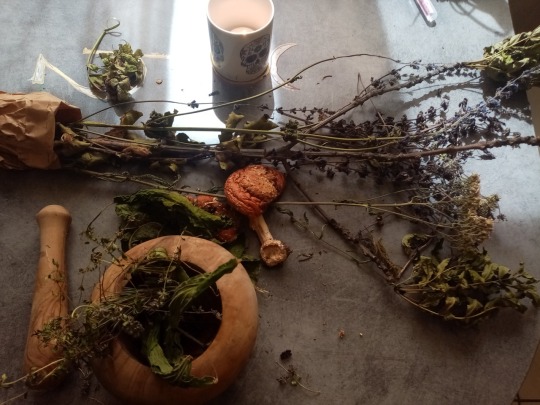
It is composed of plants from the hedge (foetid hellebore seeds and leaves, foxglove, hypericum, common salvia, viper bugloss, thymus serpillum, rumex sanguineus, etc), pine resin and leaves, black sacra frankincense, acacia gum, beech bark, leaves and, the guest star : amanita muscaria.

I'm happy with the result : it smells very woody and fresh.
This incense was crafted under the Mercury hour
131 notes
·
View notes
Photo

Rumex sanguineus - Une variété intéressante aux feuilles colorées qui lorsqu'elles sont cueillies jeunes, ajoutent un goût plaisant et piquant aux salades mixtes.
#rumex#sanguineus#salade#potager#gardeners on tumblr#edible garden#agriculture urbaine#urban farming
1 note
·
View note
Text
PERENNIAL HERBS

Want to grow fresh herbs at home? There's no need to replant these herbs! They grow back year after year.
Angelica (Angelica archangelica) (A biennial but if you let it seed, it will be perennial.)
Zones 4-9 I call this a big babe herb. With flowers, can get six feet tall and four feet wide. Good for the back of a border
Anise Hyssop (Agastache foeniculum)
Zones 4-9 One of my favorite edible flowers. Tastes just like a box of Good 'n Plenty. Probably a mid-range plant or front of the border.
Lemon Balm (Melissa officinalis)
Zones 3-7 This herb is a summer tea favorite. Once you have this herb, you will have it forever. Cut down by a third throughout the summer if you don't want it to bloom. Once you have let it bloom, it will seed wherever. I was pulling out little lemon balms in the garden today! Put this one in the front so you can clip it and use it. Has a musky lemon scent.
Catnip (Nepeta cataria)
Zones 3-9 If you have cats, you'll maybe want a fence around it to keep them off of it. They do love it. I have never grown this but I would say it would be a mid-range or front of the border herb.
Chives (Allium schoenoprasum)
Zones 3-9 Janice already has this in her garden. It is a staple in my herb garden. Love those edible flowers in my omelet in the spring. This makes a lovely border especially when it is blooming. Cut down and chop up and freeze for winter use. Mid-range or front of the border.
Garlic Chives (Allium tuberosum)
Zones 3-9 The difference in garlic chives from regular chives is that garlic chives have a flat leaf and chives have a tubular or round leaf. Garlic chives have beautiful white flowers in August when you are looking for a flower in the herb garden. Just make sure you cut those flowers the minute they finish blooming or you will end up with a garden of garlic chives. Leaves are very good in stir-fries. Mid-range or front of the border.
Sweet Cicely (Myrrhis odorata)
Zones 3-7 This is a good sugar substitute with an additional anise flavor. It reminds me of tansy. It does march along. Not super invasive and it does like the shade. It would be a good back of the border herb.
Bloody Dock (Rumex sanguineus)
Zones 4-9 This is a red-veined sorrel. It is very ornamental. It does not have the lemony taste of regular sorrel. Does well in water or by a pond. It has gently spread itself throughout my garden and/or its seeds were composted and it has been spread that way. Front of the border of your herb garden.
Purple Coneflower (Echinacea purpurea)
Zones 3-10 Trying to give you herb flowers as well as just herbs. This flower is a favorite of butterflies and the seedheads are loved by the finches and other birds in my garden. They do get sown around by the wind and the birds. One of my favorite flowers in the mid to late summer. They are not just purple either. Lots of color choices, but the granddad is the purple one. Mid-range for an herb border. Two or three plants together make a nice stand of flowers.
Elecampane (Inula helenium)
Zones 3-8 This is another big babe herb. I have always wanted to grow this plant but haven't always been able to find it. It has leaves similar to the mullein and the flowers are small and resemble a double sunflower. It would be a back of the border herb. It is used for dyeing and the root is used in the manufacture of absinthe.
Foxglove (Digitalis purpurea)
Zones 4-9 I have trouble growing these flowers. They do need some shade. Although when I have grown them in shade, they reach for the sun. They are a poisonous flower and are a source of digitalis, the heart drug. They are a mid-range flower in the herb garden.
Johnny-Jump-Up (Viola tricolor)
Zones 4-9 Very front of the border. Many gardeners get these to reseed in the garden. I have not had that luck. Love these little faces in the herb garden. Need some shade to keep going into summer. An edible flower and easy to start from seed.
Horehound (Marrubium vulgare)
Zones 4-8 Horehound is a lovely little plant with gray pebbly leaves. Make cough drops to help soothe your cough. Front of the herb garden border.
Horseradish (Armorica rusticana)
Zone 3-10 Horseradish was the 2011 Herb of the Year and can be very invasive in a garden. You might make a horseradish garden on its own. It would be a perennial herb, but just be aware that it will take over the garden unless you control it either in a pot that is deep because you are harvesting the root or by exiling it to its own bed. Has a beautiful flower in the second year.
Hyssop (Hyssopus officinalis)
Zone 3-9 Very aromatic and maybe not in the best way. Slightly bitter leaves used in soups or stews and with game meat. I do love the tiny blue or white flowers around July 4th. I would use it as a hedge in the front of the border. I need to use this herb a bit more often.
Joe-Pye Weed (Eupatorium purpureum)
Zones 3-10 I have this in the back of the border. It is another big boy herb! It does alright in shade. It is a native of the eastern US. It has rosy purple flowers in the fall. Richters catalog talks of when the leaves are crushed the smell is vanilla. Another plus!
Lady's Mantle (Alchemilla vulgaris)
Zones 3-8 This beautiful clumping herb is a beautiful addition to your herb garden. It has chartreuse flowers. The leaves are like little capes hence the name mantle. I would use it in the front of the herb garden.
Lamb's Ear (Stachys byzantina)
Zones 4-9 Wooly leaves that are a delight for children. Were used as bandages for wounds. Front of the herb garden for these. Silvery leaf color is a nice contrast for other herbs in the garden.
Lavender 'Hidcote' or 'Munstead' (Lavandula angustifolia)
Zones 4-8 These are two of the hardiest lavenders. These lavenders are the ones I would recommend you use to cook with. Any angustifolia cultivar would be edible. The other lavenders are too camphorous and not hardy in Zone 4. Mid-range or front of the herb garden for these.
Spearmint (Mentha spicata)
Zones 3-8 Most mints are invasive. If you don't want it everywhere in the garden, put it in a container. Spearmint is one of my favorite mints. Not as strong as peppermint. Delicious in tea blends. Richters calls it the best cooking mint. There are tons of mints not all of them are hardy to Zone 3 or 4 so make sure you check before buying it.
Mountain Mint (Pycnanthemum muticum)
Zones 4-6 This is a bee magnet and very fragrant. It is beautiful with fresh flower arrangements and it dries very nicely. It can be used in the back of the border or mid-border. It does run but is not invasive like regular mints.
Queen Anne's Lace (Daucus carota)
Zones 3-10 I put this in because Janice loves this in the garden and Janice, I have good news that Richters in Canada sells seeds for a reasonable price. Check it out through the link above. I had this in my garden for quite a few years. A beneficial insect magnet. I would put this in the back or mid-range part of your garden.
Fennel (Foeniculum vulgare dulce) or Bronze Fennel (Foeniculum vulgare dulce 'Rubrum')
Zones 4-9 Both of these fennels can be used in cooking. Regular fennel has green fronds and bronze fennel has purple ones. I have had bronze fennel at various times. Just cut the flower heads before they seed everywhere! Use either of these in the back of the border.
Garden Sage (Salvia officinalis)
Zones 4-9 I really love this species of herb. Garden sage is so versatile. It can be used for cooking or in potpourri or for an herb wreath. I love the gray-green leaves in contrast with other herbs. I would use this herb in the mid-range part of the herb garden.
Garden Sorrel (Rumex acetosa)
Zones 4-8 Mostly famously used in sorrel soup. It is a spring herb that has a bright lemony flavor. It has an interesting red flower spike that dries very well. The leaf is shield-shaped. We use the small early leaves in our salads. I would use this herb in the front of the herb garden.
Tansy (Tanacetum vulgare)
I would find a place of exile for this herb. It is used to repel ants and a couple of summers ago it was a haven for the various stages of the ladybug. So it doesn't repel good insects! Don't be too quick to get rid of this herb. It has fern-like leaves and can be in the back of the border but it does run so it can take over a bed if not careful. Not for culinary purposes, but mothchasers can use a bit of tansy. It has very nice yellow button flowers and I have made a very nice wreath with tansy at the end of the season.
French Tarragon (Artemisia dracunculus sativa)
Zones 3-7 This is the only tarragon to use in cooking. It is not propagated by seed. If you purchase tarragon seeds, you have the more inferior Russian tarragon.
English Thyme (Thymus vulgaris)
Zones 4-9 This is the one thyme to have for cooking. Silver Thyme (Thymus vulgaris 'Argenteus') Zones 4-8 I have some problems getting this through the winter. Sharp drainage is key. Lemon Thyme (Thymus x citriodorus) Zones 4-9 Can be creeping or upright. I really love the flavor of this thyme. Does it have anything to do with a lemon? Maybe. Mother-of-Thyme (Thymus praecox) Zones 4-8 A very robust creeping thyme. Used in cooking. All thymes are good in the front of the border.
Other thymes may be hardy. Need to check your zones.
Valerian (Valeriana officinalis) Zones 4-9 Fern shaped leaves and white flowers that have a very fragrant scent of vanilla. I don't have this enough in my garden. It needs a bit of shade in the heat of summer.
152 notes
·
View notes
Text
1. Bloody dock (Rumex sanguineus, Zones 6–8) Companion plants: 2. European wild ginger (Asarum europaeum, Zones 4–8) 3. ‘Chicago Fire’ rex begonia (Begonia ‘Chicago Fire’, Zones 12–13)

1. Bloody dock (Rumex sanguineus, Zones 6–8) Companion plants: 2. European wild ginger (Asarum europaeum, Zones 4–8) 3. ‘Chicago Fire’ rex begonia (Begonia ‘Chicago Fire’, Zones 12–13)
via RSSMix.com Mix ID 8135640 https://ift.tt/36oXwDb
0 notes
Text

30.9.2023: Rumex sanguineus
#photojournal#phototagebuch#tagesphoto#photo diary#photo of the day#photo du jour#photo des tages#vienna#wien#urban garden#blut-ampfer#botanik#30.9.2023#Rumex sanguineus
1 note
·
View note
Photo

Glowing
Red-veined dock (Rumex sanguineus)
#beautiful things#plants#9thbutterfly pictures#original photographers#photographers on tumblr#(I feel weird calling myself a photographer#that implies more skill and knowledge than I have)#at work
5 notes
·
View notes
Photo

Bloody Dock Red Sorrel and Green Belleville Sorrel Mix, Varieties Heirloom Non-GMO BN50 Green Belleville Garden Sorrel (Rumex acetosa) is appreciated in native cuisines throughout Europe and in many parts of Asia and Africa, as well. A perennial, it is available in early spring, before many annual crops have even been sown! The lemony tartness of the young succulent leaves gives a tangy twist to salads. Widely used in soups; combine with spinach for an authentic spanikopita. This cultivated variety with clear green leaves is much slower bolting than the wild species. Bloody Dock Red Sorrel (Rumex sanguineus). Stunning foliage plant with elongated, medium green leaves, exquisitely veined in a brilliant burgundy-purple. A hardy perennial, it quickly forms an attractive clump, which sends up red flower clusters in early summer, followed by brown seed heads. A superb, deer-resistant accent plant. 6-12 hours of Sun Sprouts in 10-14 Days Ideal Temperature: 65-75 Degrees F Seed Depth: 1/4" Plant Spacing: 10-12" Frost Hardy: Yes Type: Annuals, Perennials Sun Exposure: Full Sun Water: Regular Water Family: Polygonaceae Type: Annuals, Perennials Sun Exposure: Full Sun Water: Regular Water Planting Zones: 4-11 Family: Polygonaceae Rumex acetosa (Green) Rumex sanguineus (Red) Two similar species are grown for their edible leaves, which can be used raw in salads or cooked in soups, sauces, egg dishes. The flavor is like that of sharp, sprightly spinach, but sorrel is more heat tolerant and produces throughout the growing season. Common sorrel (Rumex acetosa) is a larger plant (to 3 feet tall), with leaves 6 inches long, many shaped like elongated arrowheads. It is native to northern climates. French sorrel (R. scutatus) is a more sprawling plant, to 112 feet high, with shorter, broader leaves and a milder, more lemony flavor than R. acetosa. Native to Europe, western Asia, and North Africa. The oxalic acid found in sorrel can replace lemon, which is often added to smoothies to balance out the taste. Grow sorrel in reasonably good soil. Sow seeds in early spring; thin seedlings to 8 inches apart. Or set out transplants at any time, spacing them 8 inches apart. Pick tender leaves when they are big enough to use; cut out flowering stems to encourage leaf production. Replace (or dig and divide) plants after 3 or 4 years. The plant grows to about 2 feet in height in clumps with pink flowers in racemose appearing during early summer. Growing Tips: Harvest tender leaves starting in early spring, remove flowering tops to keep leaves tender and to prevent unwanted volunteers. May become invasive in some climates. Like any other greens, wash sorrel clumps thoroughly in clean running water and rinse in salt water for about 30 minutes in order to remove dirt and any insecticide residues. The fresh herb should be used early to get maximum nutrition. To store, keep wrapped in a damp towel and place in the refrigerator for extended use (up to 3 days). Sorrel uses – Add to soups – Make it into a sauce for fish – Add to omelets and scrambled eggs – Add to stuffing for meat – Shred sorrel and stuff it into fish – Add to quiches – Add to mashed potatoes – Add to hummus – Add to pasta – Add to mixed-leaf and herb salads – Add to chard and spinach anywhere you would use those – Use as a filling for buckwheat crêpes – Make it into a pesto, to use in pasta, on pizzas, or with grilled salmon – Sorrel Smoothie Seeds are not individually packaged according to variety but are packaged in one envelope for this listing, please see other listings for individual varieties. Note: No tracking # will be provided to make the shipping cost-effective for us and free for you. Returns & exchanges Not accepted. But please contact me if you have problems with your order Our seeds are guaranteed to germinate. Once the seeds have sprouted, please understand that we cannot be held responsible for the many uncontrollable growing and climatic conditions that must be met to ensure the success of your crop(s). I try my best to make my buyers happy and would appreciate it if you'd contact me first if you have any questions or problems with your order. If you open a case before contacting me first, I will automatically block you from future purchases. Thank you for your understanding. http://springsofeden.myshopify.com/products/bloody-dock-red-sorrel-and-green-belleville-sorrel-mix-varieties-heirloom-non-gmo-bn50-1
#Blody Dock Sorrel#Red Sorrel#Green Sorrel#Belleville Sorrel#Rumex acetosa#Rumex sanguineus#Common sorrel#French sorrel#Rumex scutatus#herb seeds#rare seeds#perennial seeds
0 notes
Text
Sorrel – Herb of the Month
By Maryann Readal
Sorrel (Rumex acetosa), a tart, lemony herb, is used today primarily in cooking. However, you may have to grow your own sorrel or visit a farmer’s market or specialty store in early spring if you want to make any recipe with it.
Chopped and combined with cream and butter, sorrel makes a nice sauce for fish. If you have Eastern European or Jewish heritage, you may have had sorrel soup (schav) growing up. The leaves can be chopped and added to casseroles, or added to any soup to brighten the flavor. You can also make a pesto with the leaves or use it in combination with basil, mint, etc. to give your pesto a different flavor. Leaves can be cooked along with spinach, and baby leaves can be tossed into salads. Add it to salad dressing to give a tangy taste. It’s best to use the young leaves, as older leaves tend to acquire a more sour taste. Combining it with sour cream or cream will lessen its sourness. At one time, meat was wrapped with sorrel leaves to tenderize it. Sorrel is used in French cooking, for which the preferred species is Rumex scutatus. This species has a milder, lemon-like flavor and smaller, rounded leaves.
Sorrel was, at one time, a very popular herb in places where citrus fruits were not available. Because of its high Vitamin C content, it was eaten in the 16th-18th centuries to prevent scurvy. It was thought to also cure diseases of the mouth including loose teeth, which is a symptom of scurvy. Because of the oxalic acid in sorrel, people with arthritic, renal, and gastrointestinal disorders should eat it with caution. However, light cooking of sorrel decreases the oxalic content of the leaves. Young leaves also have less oxalic acid than older leaves.
Rumex sanguineus
The roots and seeds have been used in traditional medicines, with the roots as well as the leaves having components that produce a laxative effect. “Currently, studies on sorrel offer promising results in the areas of digestion, infection prevention, topical skin treatments, and anti-proliferative activity.” (American Botanical Council, HerbalEGram, May 2016).
In the past, sorrel was used to remove ink stains, rust, and mold from linen. Juice from the leaves makes an olive green dye, and the roots produce a bright yellow dye.
Sorrel has bright green, long, arrow-shaped leaves, and produces an inflorescence in May-June. It is easy to grow in zones 4-8. Seeds can be sown directly in the ground before the last frost. Plants can also be divided and shared. It is a perennial in my zone 8b garden. Sorrel does like acidic soil and plenty of sun, but will tolerate some shade. There is a species with red veining, Rumex sanguineus, that makes a nice accent plant in the garden. It is also edible, though it lacks the strong flavor of garden sorrel, Rumex acetosa.
Here is my mother-in-law’s recipe for sorrel soup:
Sorrel Soup
¼ lb. sorrel leaves
1 tbsp. butter
2 cups chicken broth
3 eggs yolks
½ cup cream
Salt and white pepper
Shred the sorrel leaves that have been well-washed, with the stems and center ribs removed. Cook in the butter for a few minutes until soft. Add the chicken broth and simmer for 15 minutes. At serving time, beat three egg yolks with the cream and add to the hot soup, being careful not to let it boil. Season with salt and white pepper to taste and serve immediately.
For more information and recipes using sorrel, please go to The Herb Society of America’s Herb of the Month webpage.
Medicinal Disclaimer: It is the policy of The Herb Society of America, Inc. not to advise or recommend herbs for medicinal or health use. This information is intended for educational purposes only and should not be considered as a recommendation or an endorsement of any particular medical or health treatment. Please consult a health care provider before pursuing any herbal treatments.
Maryann is the Secretary of The Herb Society of America. She is a member of the Texas Thyme Unit in Huntsville, TX. and is a Master Gardener. She gardens among the pines in the Piney Woods of East Texas.
Sorrel – Herb of the Month published first on https://marcuskeever.blogspot.com/
0 notes
Text
Adding a little sour to the salad
The crows gathered, chattering in the pine tops this morning as I knelt in the garden and set out a dozen red-veined sorrel plants. I wondered if the crows were plotting to have a taste of the lemony leaf after I left. Sorrel is a member of the buckwheat and rhubarb family, and it served as a flavorful and reliable source of nutrition for the indigenous peoples on this continent for thousands of years before European explorers arrived. The plant is kin to oxalis, the dainty wildflower also known as wood sorrel that blooms yellow, white, pink or red and has three heart shaped leaves joined at their points on the stem. Oxalis, though tiny and fragile, is also edible.
Sorrel comes up in early spring--even in poor soil--and will overwinter or reseed if you let it. With their sharp tang, sorrel leaves can be used to brighten up soups and sauces that are often created with the addition of heavy cream or an abundance of butter and shallots. It's easy to find recipes on line these days that call for sorrel as a congenial ingredient in omelets and tarts, too.
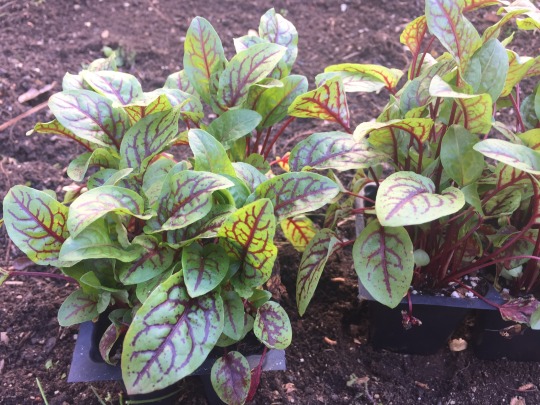
Red-veined sorrel ready for planting as an ornamental or to eat!
Sorrel is an acidic herb. It contains oxalic acid (as does spinach), which can be poisonous to humans if eaten in enormous quantity. You know that sense of something sticking to your teeth when you eat spinach? That fuzzy feeling comes from the oxalic acid in the spinach binding with calcium in your mouth. Fortunately, in addition to vitamins A and C and potassium, sorrel also contains calcium, which actually serves as a foil for the oxalic acid, according to long- ago research on spinach conducted by the famous Duke University biologist Knut Schmidt-Nielsen at the start of his wide-ranging career.
The presence of calcium in sorrel has also made the plant a beneficial ingredient in herbal creams designed to keep wrinkles away and facial skin firm, according to the Australian herb experts John and Rosemary Hemphill, who suggest that sorrel can be used to good effect in a facial steam and "can also be taken as a tea to help clear the skin."
"Sorrel seeds should be sown in March," pronounced Ms. Eleanour Sinclair Rohde in her charming little book, A Garden of Herbs, published in London in 1920 and now available free as an E-book on Google. The ever frugal Ms. Rohde argues that sorrel soup can be made with milk "but is better and cheaper with potatoes." She also mentions--in the archaic spelling of her time--that sorrel can be used "to take Staines out of ones Hands Presently. You may do this with the iuyce [juice] of Sorrell, washing the stained parts therein."
Though March is now past, it is still a fine time to plant sorrel seeds or find plants already started, as I did a few days ago at Big Bloomers Flower Farm in Sanford, North Carolina. Their greenhouses did not yet have the French sorrel (Rumex scutatus) or the common sorrel (Rumex acetosa) potted and ready for sale. And as I have learned in reading, many chefs prefer the French over the common sorrel, since the latter has broad leaves that can get quite large and bitter enough to require blanching before eating.

Oxalis growing wild between the stepping stones in my garden.
The red-veined Rumex sanguineus that I was able to buy (in four packs for $2.95) will make a colorful addition to lettuce salads well into fall if we don't have a major drought. The leaves, best picked small, are tender, lemony, and not too sour. (Sorrel means sour in French.)
I don't remember eating sorrel until the ace cook Jim Harb served it to me in a salad and then shared some seeds. Jim says he routinely combines sorrel from his garden with arugula and mint to make a refreshing first course. "It's just so bright and lemony tart that it picks up any salad," he says.
And here's an expert tip Jim sent along that is also worth considering, regardless of whatever greens you may have on hand: "A secret to luscious salad," he wrote, "is to wet the greens lightly with water. Many people take lettuce straight out of the fridge and dress it. WRONG! The greens need to be wet slightly so that the water can dissolve the salt (which should go on first). Then, comes the acidity [meaning vinegar or citrus juice or both]. If the oil goes on before, the acid can't hit the greens, so only the oil/fat covers the greens. So, water, salt, acid, and then finally oil, in that order."
Thanks, Jim. One more timely fact about sorrel caught my attention. The herb is often served as an accompaniment to fish. Shad--featured in the March chapter of my upcoming book on N.C. heritage foods through the year--are actually swimming upstream right now to spawn in North Carolina rivers. These slab-sided, silvery fish, which are larger than their near-relative the herring, have been much prized by Tar Heels in the past, but they are also known for their prodigious bones.
According to The Oxford Companion to Food, sorrel was often applied as a stuffing for shad, the belief being that the oxalic acid would dissolve the smallest, worrisome bones in the fish as it cooked, not to mention that sorrel's sharp flavor was delicious with this oily fish.
The British food writer and restaurateur Tom Jaine experimented with this theory and found it improbable. Shad bones are better dissolved by prolonged cooking, he discovered.
One last idea: pounding sorrel leaves into a paste with vinegar or lemon juice and a touch of sugar creates what the English back in Ms. Rohde's day rather unromantically called greensauce.
I shall make some greensauce this spring, and I'll let you know how it goes on, say, trout when the time comes.

Sorrel and Bibb lettuce covered in case of visiting crows, deer, or Easter bunnies.
NOTE: If you found this blog through a facebook link, please know that you can also sign up for e-mail notification of every posting. You can also unsubscribe at any time. For more information on my book that launches on September 4, please visit my website.
0 notes